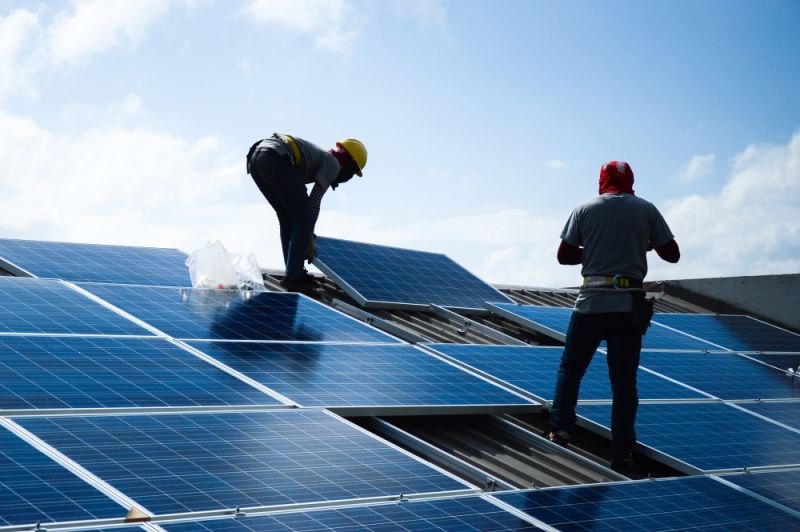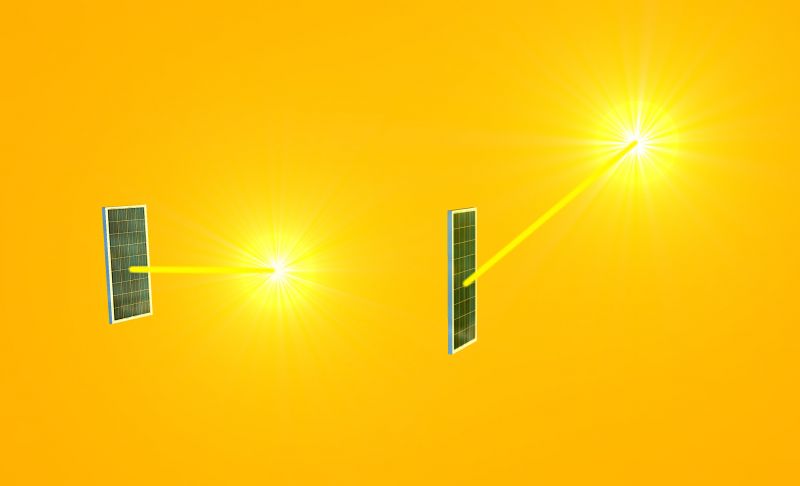At times, we are faced with the choice of buying larger solar panels to produce more energy. However, this is not always the best choice. In fact, in many cases, the best solution may be to change and improve the tilt of the solar panels rather than increase their size. In this article, we will see why the tilt of solar panels is so important and how it can affect the amount of energy produced.

The power of incident rays
The tilt of solar panels, relative to the sun, is extremely important because it affects the amount of solar energy they can capture. The correct tilt depends on the geographical location of the photovoltaic system. To get maximum productivity from your solar system and maximize the energy of the system, you should orient the panels in the direction where the incidence of the rays is most concentrated, avoiding shade as much as possible. This condition should be maintained throughout the period of solar irradiation. The best solution is to install a solar tracker system that allows the solar panels to be oriented appropriately, depending on the time of year and time of day. However, due to cost, this solution is not very feasible. Nevertheless, this article examines the physical and mathematical aspects of the issue and not the economic aspect.
Mathematics helps us choose the direction and angle
Mathematics can help choose the optimal direction and angle for solar panel installation to maximize the amount of energy produced. Specifically, trigonometry is a branch of mathematics that can be used to calculate the ideal tilt angle of solar panels, based on latitude and time of day. There are some simple formulas and tables that can help to best place solar modules. The following formula is extremely simple and is used to calculate, roughly, the tilt of the panel in both summer and winter.
Of course, these are fairly generic positions that assume a static position of the modules. Another method, which is slightly more accurate than the one just mentioned, allows the generic tilt to be calculated in one of four seasons (winter, summer, spring and autumn).
θ winter = latitude·0.9+29
θ summer = latitude·0.9-23.5
θ spring = latitude-2.5
θ autumn = latitude-2.5
With these formulas, the results are even better adapted to different seasonal conditions.
Figure 1 helps us to understand this phenomenon. Depending on its inclination with respect to the plane, it is distributed differently, and because its energy is constant, the concentration per unit area is different. The closer you get to the poles, the more the same light is distributed over a greater area and its relative power is lower. At the equator, in fact, there is a higher temperature than at the poles.

Figure 1: Light is distributed differently depending on its tilt on the surface.
The angle that makes a difference
Under ideal conditions, with the sun placed perpendicular to the solar panel, the amount of solar power dependent on it is about 1,000 W/m². This does not mean that such a panel can produce an actual power of 1,000 W. The value is much less, as most of the energy is infrared rays that generate heat. A plane oriented directly toward a source receives the maximum amount of light. But if the angle of the plane changes, the amount of light hitting a unit area decreases in proportion to the cosine of that angle. A general formula for calculating the energy of the light on the plane (both visible and infrared) is as follows:

Where E is the amount of light energy in W/m2, I is the solar radiation in W/m2, θ is the angle of incidence of light on the plane (that is, the angle between the direction of the light and the normal to the plane) and cos represents the cosine function.
With such a relationship, the following table can be created:
Therefore, a solar panel must be oriented to capture maximum light, which is achieved when its plane is perpendicular to the direction of light. The same concept can be observed in Figure 2, in which there are two different solar panels. The first on the left is hit by perfectly incident light, while the one on the right is hit by less light because the latter has a certain degree of tilt.

Figure 2: The performance of a solar panel changes according to the angle of the light.
Although solar radiation develops a power of about 1 kW/m² on the ground, that produced by a solar panel of the same surface area is much lower. This happens because the solar panel is more sensitive to some bright and visible frequencies but not to infrared, a component that is largely present in sunlight. Therefore, a 1-m² solar panel cannot produce 1,000 W of power (at least with this technology). This means that only a portion of the solar energy that hits the panel is converted into usable electricity. Its efficiency is very low and varies between 15% and 20%, although some companies have recently managed to achieve a very high efficiency of 46%, using extremely expensive materials. Technology is making great strides, and surely in the coming years, the market will be able to offer much better-performing devices.
Mirrors also contribute to efficiency
It is possible to increase the efficiency of a solar panel by using a mirror to concentrate the sun’s rays onto it. This increases the intensity of light hitting the module. However, using one or more mirrors requires careful design and installation, as excessive temperature could cause damage to the system. It also requires a lot of available space so that the mirrors can be placed appropriately.
Conclusion
If you want to improve the efficiency of an existing solar system, the best solution might be to change the angle of the solar panel instead of replacing it with a new one. This is because the angle of light is a critical factor that determines the efficiency of solar power generation. By changing the tilt, it is possible to improve the amount of sunlight the panel receives, thereby increasing its ability to produce electricity. In addition, this solution can be cheaper and less invasive than replacing the entire system. Sometimes, non-professional installations can be seen outside, which have panels oriented in opposite directions to the sun, because users have no other possible solution. Before deciding whether to add onto or replace your solar panels, consider changing their tilt.

The power of incident rays
The tilt of solar panels, relative to the sun, is extremely important because it affects the amount of solar energy they can capture. The correct tilt depends on the geographical location of the photovoltaic system. To get maximum productivity from your solar system and maximize the energy of the system, you should orient the panels in the direction where the incidence of the rays is most concentrated, avoiding shade as much as possible. This condition should be maintained throughout the period of solar irradiation. The best solution is to install a solar tracker system that allows the solar panels to be oriented appropriately, depending on the time of year and time of day. However, due to cost, this solution is not very feasible. Nevertheless, this article examines the physical and mathematical aspects of the issue and not the economic aspect.
Mathematics helps us choose the direction and angle
Mathematics can help choose the optimal direction and angle for solar panel installation to maximize the amount of energy produced. Specifically, trigonometry is a branch of mathematics that can be used to calculate the ideal tilt angle of solar panels, based on latitude and time of day. There are some simple formulas and tables that can help to best place solar modules. The following formula is extremely simple and is used to calculate, roughly, the tilt of the panel in both summer and winter.
θ winter = latitude+15
θ summer = latitude-15
θ summer = latitude-15
Of course, these are fairly generic positions that assume a static position of the modules. Another method, which is slightly more accurate than the one just mentioned, allows the generic tilt to be calculated in one of four seasons (winter, summer, spring and autumn).
θ winter = latitude·0.9+29
θ summer = latitude·0.9-23.5
θ spring = latitude-2.5
θ autumn = latitude-2.5
With these formulas, the results are even better adapted to different seasonal conditions.
Figure 1 helps us to understand this phenomenon. Depending on its inclination with respect to the plane, it is distributed differently, and because its energy is constant, the concentration per unit area is different. The closer you get to the poles, the more the same light is distributed over a greater area and its relative power is lower. At the equator, in fact, there is a higher temperature than at the poles.

Figure 1: Light is distributed differently depending on its tilt on the surface.
The angle that makes a difference
Under ideal conditions, with the sun placed perpendicular to the solar panel, the amount of solar power dependent on it is about 1,000 W/m². This does not mean that such a panel can produce an actual power of 1,000 W. The value is much less, as most of the energy is infrared rays that generate heat. A plane oriented directly toward a source receives the maximum amount of light. But if the angle of the plane changes, the amount of light hitting a unit area decreases in proportion to the cosine of that angle. A general formula for calculating the energy of the light on the plane (both visible and infrared) is as follows:

Where E is the amount of light energy in W/m2, I is the solar radiation in W/m2, θ is the angle of incidence of light on the plane (that is, the angle between the direction of the light and the normal to the plane) and cos represents the cosine function.
With such a relationship, the following table can be created:
| Angle | Cosine of angle | 0 | 1.000000 | 10 | 0.984807 | 20 | 0.939692 | 30 | 0.866025 | 40 | 0.766044 | 50 | 0.642787 | 60 | 0.500000 | 70 | 0.342020 | 80 | 0.173648 | 90 | 0 |
Therefore, a solar panel must be oriented to capture maximum light, which is achieved when its plane is perpendicular to the direction of light. The same concept can be observed in Figure 2, in which there are two different solar panels. The first on the left is hit by perfectly incident light, while the one on the right is hit by less light because the latter has a certain degree of tilt.

Figure 2: The performance of a solar panel changes according to the angle of the light.
Although solar radiation develops a power of about 1 kW/m² on the ground, that produced by a solar panel of the same surface area is much lower. This happens because the solar panel is more sensitive to some bright and visible frequencies but not to infrared, a component that is largely present in sunlight. Therefore, a 1-m² solar panel cannot produce 1,000 W of power (at least with this technology). This means that only a portion of the solar energy that hits the panel is converted into usable electricity. Its efficiency is very low and varies between 15% and 20%, although some companies have recently managed to achieve a very high efficiency of 46%, using extremely expensive materials. Technology is making great strides, and surely in the coming years, the market will be able to offer much better-performing devices.
Mirrors also contribute to efficiency
It is possible to increase the efficiency of a solar panel by using a mirror to concentrate the sun’s rays onto it. This increases the intensity of light hitting the module. However, using one or more mirrors requires careful design and installation, as excessive temperature could cause damage to the system. It also requires a lot of available space so that the mirrors can be placed appropriately.
Conclusion
If you want to improve the efficiency of an existing solar system, the best solution might be to change the angle of the solar panel instead of replacing it with a new one. This is because the angle of light is a critical factor that determines the efficiency of solar power generation. By changing the tilt, it is possible to improve the amount of sunlight the panel receives, thereby increasing its ability to produce electricity. In addition, this solution can be cheaper and less invasive than replacing the entire system. Sometimes, non-professional installations can be seen outside, which have panels oriented in opposite directions to the sun, because users have no other possible solution. Before deciding whether to add onto or replace your solar panels, consider changing their tilt.
Cool? Ranking DIY



